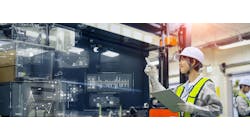Manufacturing supplied the seeds that grew into industrial automation. While some of the technology used was a result of the race to space back in the 1960, manufacturing was the high-volume driver. Industrial automation vendors, manufacturers and machine builders continue to chase and develop automated equipment and processes and will continue into the future.
Outside the manufacturing sector, why don't these vendors, manufactures and builders spread their wings into the commercial spaces and start developing automation for the service industry, restaurants, banking, retail or security? Shouldn't the commercial space benefit from automation? Aren't there big opportunities?
"There are automation opportunities outside of manufacturing that will be driven by two main factors: cost reduction and safety, or risk reduction," says David Paul, engineering design manager at Maverick Technologies, a member of the Control System Integrators Association (CSIA), headquartered in Columbia, Illinois. "Find the right opportunities where automation will reduce cost and risk, and automated systems are soon to follow. As long as it is less expensive or minimally risky, humans will continue to fill many jobs that could be automated. An example of automation in another industry is aviation—for example, modern transport class aircraft (Figure 1). These machines operate in high-risk environments, such as aviation, and have risk-reduction requirements for safety. Modern transport class aircraft are automated to a point where they can practically fly from Point A to Point B without the pilot. Yes, the pilot must configure the flight control system for the flight and must be ready to respond correctly in an abnormal situation; beyond those unusual situations, however, transport category aircraft are highly automated just like you would find in an industrial facility controlling a highly exothermic process."
Figure 1: Complex cockpit automation has reduced the pilot workload and increased flight safety while eliminating the need for a flight engineer.
Again, safety and cost reduction drove these changes in aviation. "Transport class aircraft are now flown by a two-person crew of pilots," says Paul. "Thirty years ago, transport class aircraft usually required a three-person crew: two pilots to fly the plane and a flight engineer to manage the systems. Cockpit automation has reduced the pilot workload, reducing cost with less crew and has increased safety with automated control and monitoring of aircraft systems."
Another industry leveraging automation and data analysis is agriculture. "Tractors and harvesting machinery through automated guidance systems can now drive themselves to plant, cultivate and harvest crops," says Paul. Once again, the driving factors for this are increased efficiency and reduced input costs.
There are also environmental benefits due to the decreased use of fertilizer, pesticides and herbicides. "Agriculture now has a closed-loop system where the yield data collected during harvest is used to adjust inputs, such as fertilizer or seeding rates, during the planting process to compensate for variabilities in agronomic conditions in the field," says Paul. Where it makes economic or safety sense, other industries will adopt automation that has measurable benefits.
Get a foothold to high quantity
"Building one of something and getting it working correctly is very difficult," says Gary H. Lucas, director of innovation at Innovative Treatment Products (www.innovatreat.com) in Owings Mills, Maryland. "Usually when you are done with the first machine or process, you can often see all the ways it can be simplified. If that one machine must work, your focus is ensuring that it works, and not the cost. Most of the commercial service industries are all high volume, with lots of variables that you can’t control. Making $10,000 from one sale to making $10 from each of 1,000 sales is a transition few companies can pull off successfully. Also costs of parts don’t drop significantly from 1 to 1,000 pieces. Get to a million and the costs are dramatically different."
Owens Design has moved into other automation areas. "It takes several years to get a foothold in a new industry," says Doug Putnam-Pite, director of software development at Owens Design in Fremont, California. "Without previous experience in a industry it is very difficult to get new customers to believe your company can successfully execute on projects in these new, to company, industries. Historically, we have chosen new industries where we have some overlap or can leverage existing knowledge in these industries. Even so, it is a large commitment to move into a new industry.”
Automation differs
Few suppliers of industrial automation get a foothold in the commercial space. "Generally speaking, these other industries have totally different definitions of automation, says John Kowal, director, business development, at B&R Industrial Automation. There are also different sales channels, cost/performance requirements and expertise, along with entrenched, existing, trusted suppliers that could no more displace an industrial automation supplier than we could displace them."
Kowal has worked with restaurant point of sale, building automation, medical imaging, security and other non-factory automation applications (Figure 2). "Commercially, the barrier to entry is significant, the competition fierce and nobody out there cares whether we can do 250-microsecond network updates with nanosecond jitter," he says.
Figure 2: While the barrier of entry is significant and competition fierce, requirements and opportunities will be clear once the requirements defined.
However, much is being automated. "Automation is used extensively outside the manufacturing and process control industries," says Arun K. Sinha, engineer with Opto 22. "Opto 22 has customers with a wide variety of applications that span many verticals and business types. Some examples include energy, HVAC and building controls, transportation, agriculture and entertainment, just to name a few."
There are many examples of this happening already. "For example, machines and robots are under evaluation for use in fast food restaurants," says Aurelio Banda, former president and CEO at Beckhoff Automation. "While numerous concepts are talked about for serving customers of all kinds of businesses in person, many have already been deployed behind the scenes for e-commerce and smart factory applications. Nobilia, Europe’s largest manufacturer of fitted kitchens has deployed similar concepts in the company’s manufacturing facilities. By connecting its PC-based machine control platforms to real-time data from customer orders across Europe, barcoded materials are assembled in lot-size-1. Nobilia assembly lines work together in perfect timing so that a custom kitchen can be completely loaded onto a specific truck for on-time delivery. This includes all cabinets, electrical appliances and accessories specified exactly as the customer ordered."
Industry 4.0 connects
"Industrial automation represents a large, global and highly monetizable market,” says Sanket Amberkar, senior vice president of marketing at Falkonry. "The opportunity to make an impact in other sectors such as security, IT automation and healthcare exists. However, optimization for human-centered processes and activities seen in the service industry has a very different set of requirements. The workflow and algorithms developed for industrial operations do not necessarily translate as seamlessly across the domains very well. Nor does the evaluation criteria."
Industrial automation tends to be much more specialized than other industries that also have automation, says Allen Tubbs, product manager IoT at Bosch Rexroth, a member of CSIA. "The production volume of a vending machine design, as an example, dictates a different design as compared to a food-packaging machine that may only be reproduced 10 times (Figure 3)," he says. "This means that, for low-volume, customized machinery, good engineering tools are needed to make custom design work easier and reusable in new applications. But there is technology overlap from other non-manufacturing industries, especially in the realm of Industry 4.0. We are seeing new products and services in technologies like artificial intelligence, augmented reality and mobile data connectivity that are commonplace in the retail market. And we are seeing a merging of data from different business sectors to create new business models and optimize production efficiency."
Figure 3: Creating a design for a vending machine is different from that of a low-volume packing machine, but there is technology overlap.
Consider the IoT and Industry 4.0 "When you think about Industry 4.0, the ability to deliver important diagnostic information to a service organization opens up opportunities in commercial applications," says Bob White, training and digital services manager at Kollmorgen. "The ability to engage in a specific service to monitor health of machines and perform preventive maintenance to improve uptime is an example of just that—something that’s certainly viable with today’s technology (Figure 4)."
Figure 4: Whether monitoring the health of a machine or the human heart, proper application of today's technology results in improved uptime.
Real applications
"There are definitely growth areas that we are targeting through our integration partners who bring expertise to a variety of commercial markets," says Geoff Dawson, director of sales, Michigan region, at Fanuc. "Fanuc is currently working with a company by the name of Miso Robotics, which has developed Flippy, the hamburger cook. This solution uses advanced vision and motion technology to give the robot sight and dexterity to emulate the skills of a short-order cook in the kitchen. The vision system determines the location and readiness of a burger to be flipped and the motion software allows the robot to flip the burger in a manner akin to its human counterpart. We look at these types of challenges on a daily basis to determine if there is an opportunity to solve the problem with an industrial robot. With ecommerce continuing its growth, we see large opportunities in the distribution and logistics markets. This has even trickled down to kiosks for the purchase of retail goods. Automation has affected our lives in so many ways from the ATM machine at the bank to the self-checkouts at the grocery store."
Schneider Electric is already doing this through its EcoStruxure system architecture, which is applied across six domains: machine, plant, building, power, IT and grid, says Simone Gianotti, EcoStruxure industry business development manager at Schneider Electric. "Applying this consistent approach to each of these domains allows us to leverage the advancements in IoT, mobility, sensing, cloud, analytics and cybersecurity in the solutions that we offer," he says. "There is a tremendous opportunity for manufacturers to provide the complete solution in each of these areas."










